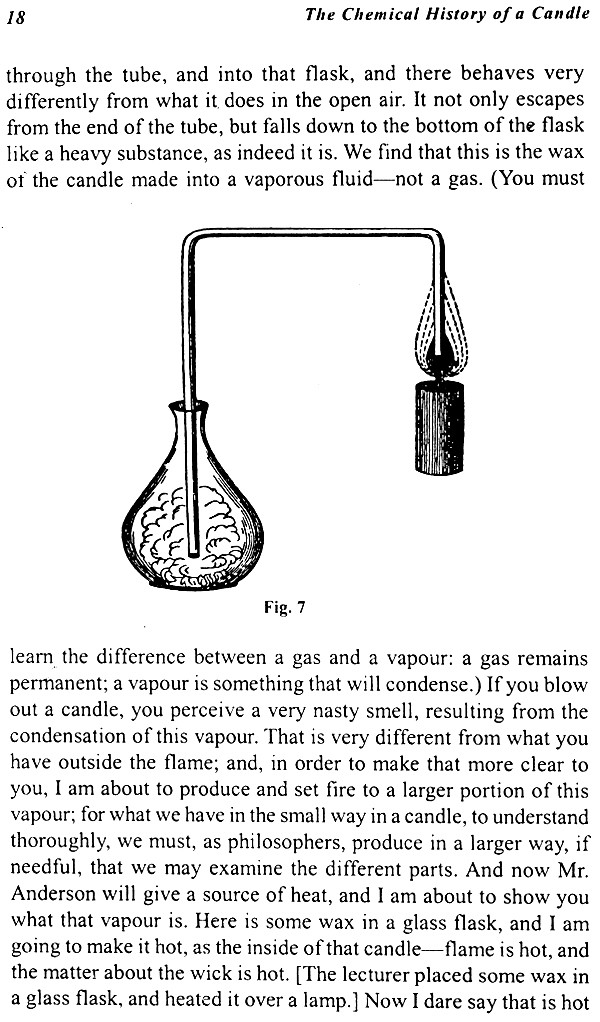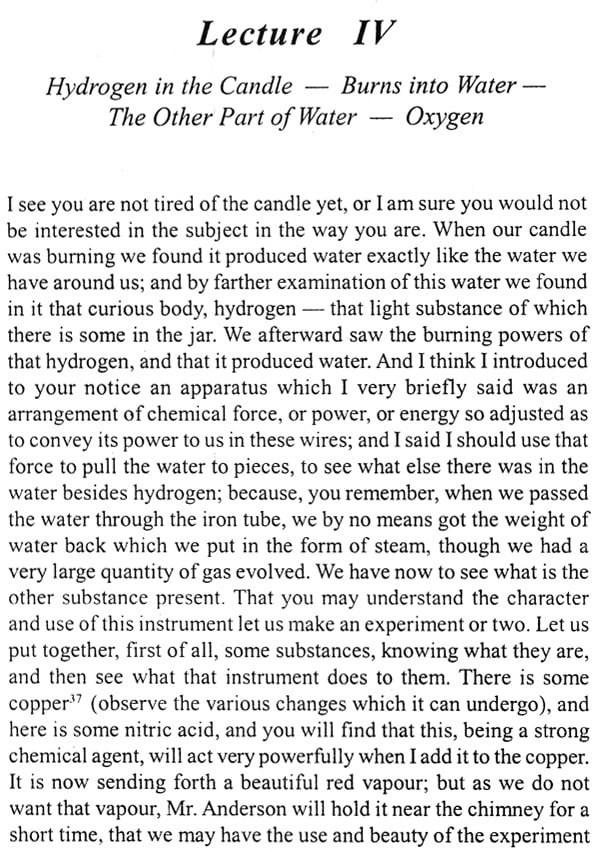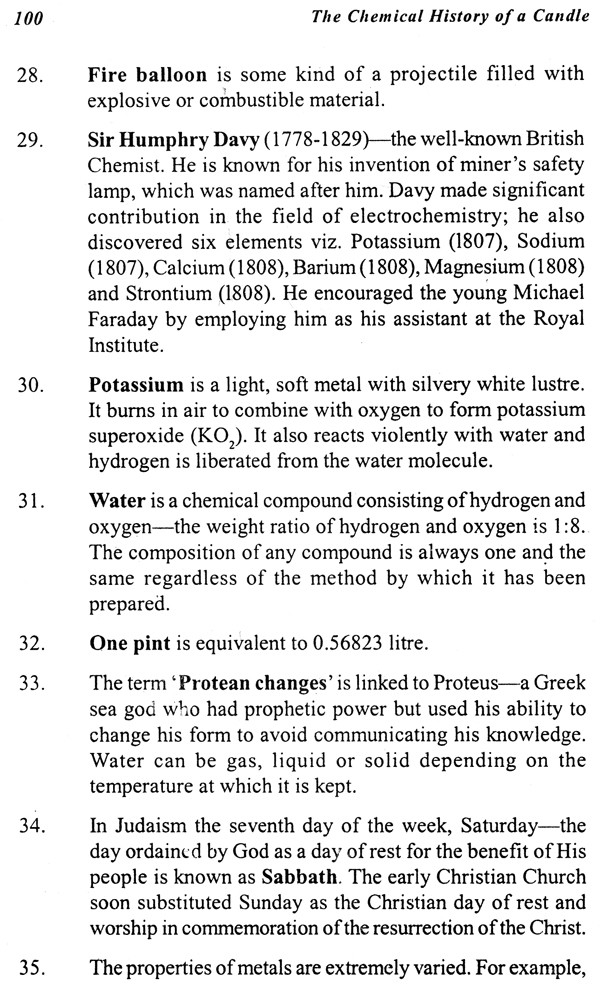
The Chemical History Of A Candle
Book Specification
| Item Code: | NBZ445 |
| Author: | Michael Faraday |
| Publisher: | VIGYAN PRASAR |
| Language: | English |
| Edition: | 2011 |
| ISBN: | 8174800026 |
| Pages: | 103 (Throughout Black and White Illustrations) |
| Cover: | PAPERBACK |
| Other Details | 8.50 X 5.50 inch |
| Weight | 180 gm |
Book Description
"Much has been written about Faraday and much more will be written-and read-not only because of the enormous significance of his discoveries and the profusion of historical material, but also because his life has a romantic 'rags to riches' quality and a nearness to perfection which will forever be an inspiration to those whose love for science may seem to be unmatched by opportunity or formal education."
The above statement which so aptly describes why Faraday's life and his work are so appealing to many was made by George Porter, F.R.S., in his Foreword to the book Faraday Rediscovered: Essays on the Life and Work of Michael Faraday (1791-1867), edited by David Gooding and Frank A. J. L. James.
Michael Faraday was born in a poor London family on 22 September 1791. His father was a blacksmith, who came to London in search of work. We .do not know much about his childhood. His father's income was not enough to meet the basic needs of the family; so, from his childhood itself, Faraday had to think of ways to augment the family income. When he was thirteen he started delivering newspapers for a Mr. George Riebau-an émigré from France. Besides letting out newspapers, Riebau was also engaged in reselling and rebinding old books. Riebau was a kind man. After a year he engaged Faraday as a paid apprentice to learn the art of book binding. This brought Faraday in close proximity of books stocked for reselling and brought in for rebinding.
Moreover Faraday got a chance to train his hands in using tools with precision and dexterity, which later became very useful in designing and handling scientific instruments. The proximity of books stimulated his ever-inquisitive mind and he started reading whatever books came to his employer's shop. Initially his reading was indiscriminate and without any definite purpose.
From the primitive pine torch to the paraffin candle, how wide an interval! Between them how vast a contrast! The means adopted by man to illuminate his home at night stamp at once his position in the scale of civilization. The fluid bitumen of the far East, blazing in rude vessels of baked earth; the Etruscan lamp, exquisite in form, yet ill adapted to its office; the whale, seal, or bear fat, filling the but of the Esquimaux or Lap with odor rather than light; the huge wax candle on the glittering alter; the range of gas-lamps in our streets, all have their stories to tell. All, if they could speak (and after their own manner they can), might warm our hearts in telling how they have ministered to man's comfort, love of home, toil and devotion.
Surely, among the millions of fire-worshipers and fire-users who have passed away in earlier ages, some have pondered over the mystery of fire; perhaps some clear minds have guessed shrewdly near the truth. Think of the time man has lived in hopeless ignorance; think that only during a period, which might be spanned by the life of one man, has the truth been known!
Atom by atom, link by link has the reasoning chain been forged. Some links too quickly and too slightly made have given way, and been replaced by better work; but now the great phenomena are known, the outline is correctly and firmly drawn, cunning artists are filling in the rest, and the child who masters these Lectures knows more of fire than Aristotle.
The candle itself is now made to light up the dark places of nature; the blowpipe and the prism are adding to our knowledge of the earth's crust, but the torch must come first.
Among the readers of this book, some few may devote themselves to increasing the stores of knowledge: the Lamp of Science must burn. Alere Flammam.
When an old book is considered for republication, several questions often crop up. They could range from "why should the book have remained out of print for so long?" to "what's so great about it anyway?" The answers depend on one's perception but it's absolutely loud and clear in the case of some classics. Here is one such classic-to reproduce which for our discerning readers is one verdict that brooks no ambiguity whatsoever!
Books are increasingly viewed as a means of personal satisfaction. Which means if there is no such promise one is not apt to read them? Francis Bacon (1561-1626)-the father of experimental science had declared, "I have taken all knowledge to be my province" and said: "Reading maketh a full man; conference a ready man and writing an exact man". He also advised: "Read not to contradict and confute; not to believe and take for granted; not to find talk and discourse; but to weigh and consider".
Today, Bacon's observations are not likely to be appreciated by many because they may not be' interested in pondering over the contents of a book once they have used it. Fortunately, however, this is not the case with every reader or every book otherwise the lamp of knowledge burning constantly since the dawn of human civilization would have long ago extinguished. There are serious readers who are inclined to "weigh and consider", and amenable to creative interaction between them and the books taking place. For example, What is Life by E. Schrodinger (1887-1961)-one of the founders of quantum mechanics- influenced many a physicist to venture into and revolutionalize Life Sciences. Similarly, Essays on Population by Thomas Robert Malthus (1766-1834) helped Charles Robert Darwin (1809-1882) to conceptualize his thoughts on evolution, which in turn, resulted in another great scientific classic, Origin of Species.
**Contents and Sample Pages**












